#I hope Kui creates more works in the future
Explore tagged Tumblr posts
Note
whos ur fave delicious in dungeon character?? :3
Omgg. Honestly I adore the whole cast so much, which isn’t a surprise— Everyone’s so well written. I enjoyed learning more about them in Ryoko Kui’s short snippets. I can ramble about everyone and what I love about them 😭
However, If we were to talk about favorites I narrowed it down to 3 (+2 ish characters)
I love lovee Marcille. She’s my ultimate fave, I won’t dive into spoilers much but I find her to be a perfectly flawed character. I love how as the story goes further, we learn so much about why she acts the way she does. Aside for Marcille, I also love Falin. Her design really speaks to me— I’m a big sucker for short hair + baggy clothes 😭. And, she’s such a gentle soul which is ironic because it contrasted what happened to her in the later parts of the story. (Also if it’s not already obvious I’m a big Farcille shipper lol 😭)
I also like Thistle because similarly to Falin I adore his design (Jester designs are also a big yes for me) he also parallels Marcille a lot which mwehehehe makes for some nice character analysis.
Special shout out to Lycion and Fleki who both give me severe gender envy. 🫡🫡
Some 5 minute doodles below while I was in the car 🫡


#taters yap#answers#delicious in dungeon#dunmeshi#I hope Kui creates more works in the future#I adore her style sm#I got the golden hour book just to stare and study her style#taters doodles#kanaetot
10 notes
·
View notes
Note
Re: How Dungeons Work
While scolding Laios and Marcille, Flamela mentions that the Canaries would need to prepare a replacement Lord if Marcille wanted to step down. The Lion also mentions falling into the Canaries' hands, and after it is defeated the Queen seems to lament that the Magic/Spell That Grants Any Wish has been lost.
Maybe the Elves were using Dungeons to do something after all?
I find it interesting that the Queen's remark can be read as referring to the Demon itself as a kind of spell, almost like a construct or AI. Thoughts on that?
Lastly, the Ancients built the Dungeons as a counter to the demon's consumption of desires. Do you think they succeeded? Is there a way to use them safely? After all, the Ancients were destroyed by a wish/their own will, not by the demon's agency. Maybe they and maybe even modern Elves know how to act as Lord without getting eaten at all? It seems technically feasible from what we see, Thistle just sealed it away too late.
Hello!
Going by each question
I think they would need a replacement specifically in Marcille's case since she wants to step down, they cant move her to the surface because the dungeon is already spilling out. I imagine the subistitute lord is a temporary solution to remove Marcille from the Dungeon (someone with less destructive wishes)
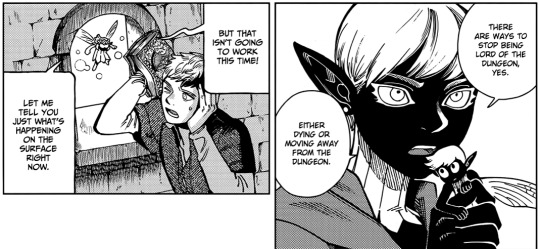
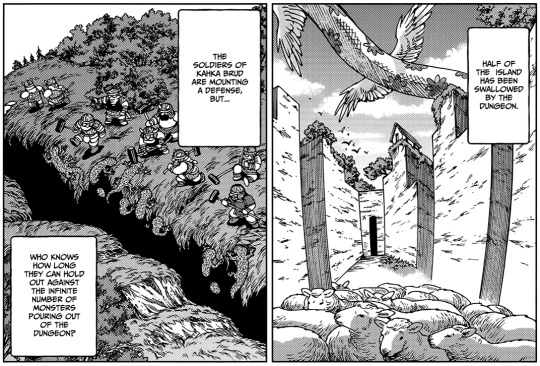
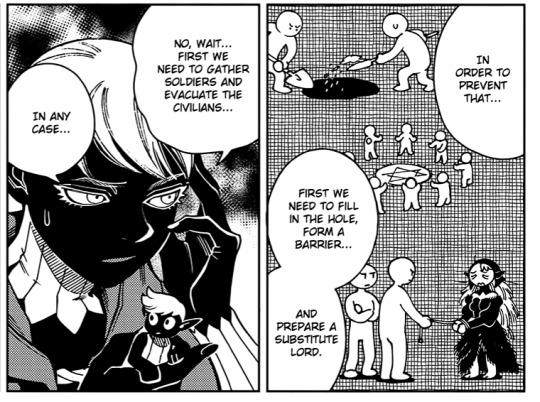
I don't think the elves are doing anything with the dungeon from their track record, since they collapse dungeons, what Kabru dislikes is how they go about it (with no regard for other's), Utaya is an example of just how destructive Dungeons can be. (The canary plans are always to collapse dungeons and there's no hint about it being anything else is there?)
The queen is a weirdo, but to me the way she talks about it sounds more like a relief "'The spell that grants any wish' has been lost. there is time" as in that is no longer an impending danger for their world? EHScans even translates it as "we have the luxury of time"
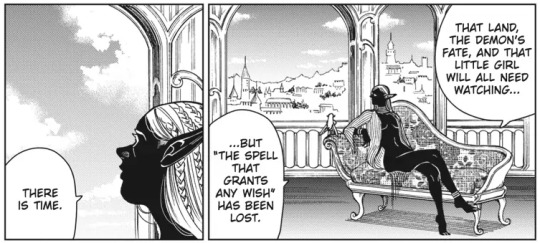
In the world there's also no difference between the demon and magic itself, as we learn in chapter 87 the demon is magic given personality so she's not wrong to call him that.
I think the ancients succeeded in the sense that they managed to seal the demon inside dungeons, but they had the plot lost from the start, having all you wish for granted goes against being a living being, craving and wishing is part of living so it was doomed to fail as it did. The demon also doesn't understand ofc
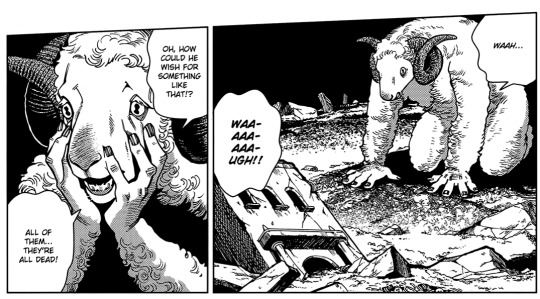
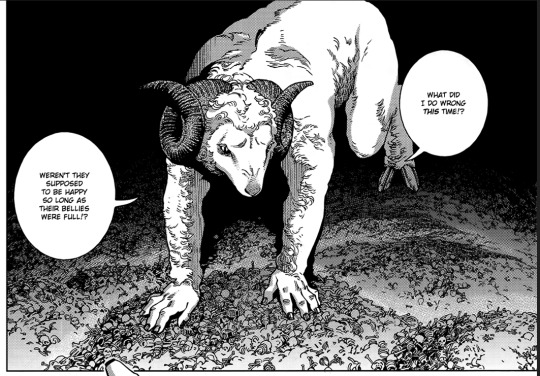
As I said it goes against being human so I don't think it's possible at all to use the demon, you would end up just like the ancients wishing for everyone to die, the best example of why this would never work Kui gives us is the tale Laios tells in the nightmare monster tidbits
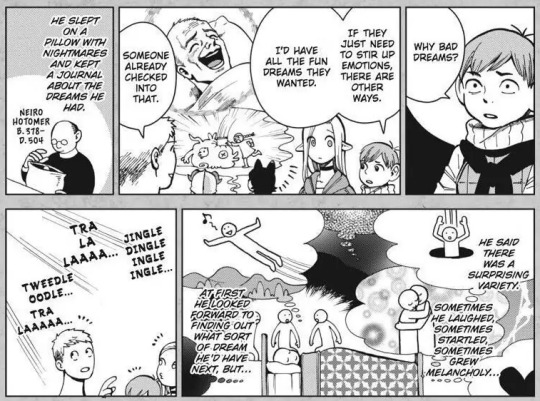
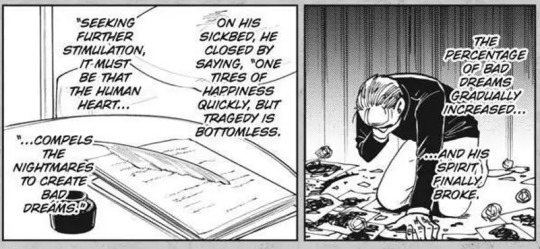
"One tires of happiness quickly, but tragedy is bottomless. Seeking further stimulation, it must be that the human heart compels the nightmares to create bad dreams"
The future the Demon wanted granting everyone's wishes would have probably also ended up in a living hell for them.
Also I don't think Thistle 'sealed him away too late', he kept deteriorating even after locking up the demon it seems. Marcille suffers from it too even after sealing him.
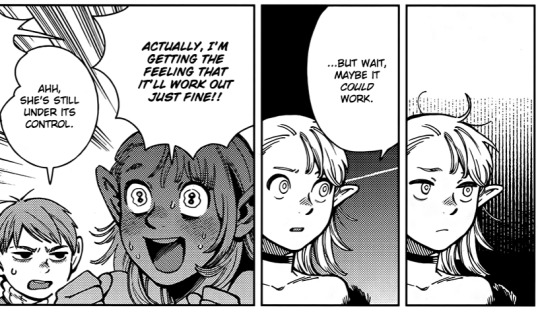
hope these answers helped!
#Dungeon Meshi spoilers#magic system#dungeons#Demon#ancient magic#elves#dungeon lords#dunmeshi thoughts
85 notes
·
View notes
Text
Hey all, Dani here.
We have almost made it halfway through 2019, and I am both looking forward to and dreading my wrap up for this month. Because after we’ve made it through June, I get to write up my Top Ten Reads of 2019 (Jan-June), and I already have a dozen contenders on my list…plus whatever I end up reading in June. I’m going to end up with quite a few honorable mentions. But that’s okay; it just means I’m reading some darn good books.
Anyway, before I get fully into my wrap up for May, let’s first do a check-in on how I’m doing with my overall goals for 2019.
Reading – I read 21 books in May, which is pretty darn good overall. Quite a few of the books I read were fantasy reads, because I was participating in Wyrd & Wonder, but toward the end of the month my mood swung over to contemporary romance, which ended up working because of Books & Munches’ Moody May. Actually, I should check to see if I have all of those books logged in Goodreads because my reading challenge total might be wrong. Okay, yeah, my Goodreads was missing 7 books, so my total books read thus far in 2019 is 90 books, which is honestly a bit mind-boggling. I just increased my reading goal from 75 to 100, and I should be achieving the 100 mark in June, so I don’t know what I’m going to do with myself. Obviously I need to work on reading some more of my Big Books, so we’ll see how that goes.
Blogging – At the beginning of the month I had my blogger burnout weekend, but since then I’ve been back at it and there’s been a post on the blog every day. And Damian got back into the swing of blogging as well, so in total we had 35 posts go up on the blog in May, which is awesome. I also decided to finally start up Discussion posts, and to bring back my Recommendations posts. Oh, and I got back into doing some book tags–and I’m thinking of creating a couple book tags so look for those in the next couple of months.
Writing – I made it one of my big goals for the year to get back into writing, and so far I’ve pretty much failed at it…because I don’t count all of this blog writing in this category. I’ve written a lot of words for the blog. I need to get back into creative writing, and I really want to, but I’m just not feeling completely in the right space to do it. I think I really need to get myself a writing space set up in the house. That way I can actually have a space where I sit in it and that is where I do my writing.
Conventions – We bought our hotel room for Gen Con, and we also went through all of the panels and events and got our tickets for the ones we’d like to do. Damian is doing a lot of crafting events, which is really cool, and it is something he will definitely enjoy. I will be spending most of my time at the Gen Con Writers Symposium, so I will hopefully be learning more about the craft of writing, as well as how to make a writing schedule and stick to it, and also how to get out of this writer’s resistance/writer’s block I’ve been in for a while. And of course, when we aren’t at events, we’ll be wandering the show floor and play testing some tabletop games, which should be a lot of fun.
All right-y then. Now that we’ve looked at the overall 2019 goals, let’s get to wrapping up everything I read in the month of May–wow, I almost typed March instead of May, lol. It was a pretty good month of reading for me, and I managed to tackle some anticipated releases and read some pretty awesome fantasy reads. As always, I will link back to the review if I have one written.
Dark Shores by Danielle L. Jensen — 4.5 stars
How to Treat Magical Beasts Vol 3 by Kaziya — 5 stars
The Tiger at Midnight by Swati Teerdhala — 5 stars
My Hero Academia Vigilantes Vol 4 by Hideyuki Furuhashi and Betten Court — 4 stars
Fruits Basket Collector’s Edition Vol 1 by Natsuki Takaya — 4 stars
Ran and the Gray World Vol 1 by Aki Irie — 3 stars (Damian’s review is at this link too)
That Time I Got Reincarnated as a Slime Vol 1 by Taiki Kawakami — 4.5 stars (Damian’s review can be found here)
Fruits Basket Collector’s Edition Vol 2 by Natsuki Takaya — 4 stars
The Poppy War by R.F. Kuang — 5 stars
We Hunt the Flame by Hafsah Faizal — 4.5 stars
The Missing of Clairedelune by Christelle Dabos — 4 stars
Aurora Rising by Amie Kaufman and Jay Kristoff — 5 stars
My Favorite Half-Night Stand by Christina Lauren — 5 stars
The Unhoneymooners by Christina Lauren — 5 stars
Dragon Goes House Hunting Vol 2 by Kawo Tanuki and Choco Aya — 4 stars
Delicious in Dungeon Vol 3 by Ryoko Kui — 4 stars
Seven Blades in Black by Sam Sykes — 5 stars
She Just Wants to Forget by R.H. Sin — 3.5 stars
How Not to Summon a Demon Lord Vol 4 by Yukiya Murasaki and Naoto Fukuda — 4.5 stars
Lover Unbound by J.R. Ward — 4 stars
Whew, that was a lot of books. Now onto what we watched in the month of May. We realized that since we get satellite internet that isn’t the greatest, we can’t stream videos anymore without eating up all of our data allotment pretty early in our monthly cycle, so we’ve been watching a lot of DVDs, and we also cancelled our Netflix. It didn’t make sense to pay for something we weren’t going to be able to use. We’re hoping that some other internet providers will look to expand their service options because this is not an ideal situation for us. We literally had to leave our old internet provider because they service out to the 1300 “block” and we live in the 1400 “block,” so if they find a way to extend out a few extra miles we’ll be able to go back to our old unlimited data provider, which would be pretty awesome.
Anyway, we watched “Push” (4 stars), season 5 of “Game of Thrones” (4.5 stars), “Detective Pikachu” (4.5 stars), season one of “Eureka” (5 stars), season 6 of “Game of Thrones” (4.5 stars), “Deadpool” (5 stars), “Aladdin” (5 stars), season 2 of “The Big Bang Theory” (5 stars), “How to Train Your Dragon” (5 stars), “How to Train Your Dragon 2” (4.5 stars).
With the reading and watching wrapped up, it is time to move in to book haul and OwlCrate unboxing time.
The photo with the Magic the Gathering book and the manga and the photo with the geek dad book are both Damian’s haul–and no, we aren’t expecting. I just know that Damian loves crafts and this book was on a shelf of books to get dad for Father’s Day. It’s about doing geeky crafts with your kids, so I thought it would be cool for the future.
I really like the Howl’s Moving Castle sticker, and the passport holder. The only thing I’m not happy with in this box is the art print. It is two sided and has one of the main characters on each side, so if you put it up on your wall or something you have to choose which character to show off. It was still a really nice box, and I’m looking forward to June’s box (that special edition Sorcery of Thorns by Margaret Rogerson is going to be excellent)
Finally, it is time to talk TBR. I’ve already mentioned my tentative and not complete TBR for #AGameofBooksathon, but I also need to mention that I’m also participating in Books & Munches Jazzy June, wherein we re-read old favorites or give a second chance to books we’ve read before and were on the fence with. There are a couple of books I’m wanting to read again, so this works for me. I also have a couple ARCs I need to read and review, so it should be a pretty good month for reading. Plus, June is GLBT Book Month, as hosted by the American Library Association (ALA), so I’d like to have a few Pride focused reviews and posts on my blog this month.
All right, well I think that is all from me today, but I’ll be back soon with more bookish content.
May Wrap-Up and June TBR Hey all, Dani here. We have almost made it halfway through 2019, and I am both looking forward to and dreading my wrap up for this month.
#ARC#Books!#Calendar Girls#Conventions#Discussion#Dungeons & Dragons#Gen Con#Movies#Reading#Review#TBR#Writing
0 notes
Text
Hyperallergic: Required Reading
A very unique monument is being unveiled in Ireland, according to reporter Naomi O’Leary: “Sculpture to be unveiled in Cork to remember generosity of the Choctaw Nation, Native American tribe that sent famine aid to Ireland in 1847.” It’s by artist Alex Pentek. (via Twitter/NaomiOhReally)
Writing for the Washington Post, Philip Kennicott suggests that arts groups cannot afford to take Koch Brothers funds anymore, considering the world’s climate is at stake:
It is impolite, in critical circles, to link the politics of major donors to the cultural institutions they support. Many of our cherished arts organizations were created by Gilded Age plutocrats, yet are no longer tethered to the Darwinian social views of their originators. But cultural organizations exist in a complicated moral world, in which every dollar they collect is a dollar that isn’t being used to ameliorate poverty or cure disease. Most of us tend to deal with this dilemma by arguing that the good done by cultural organizations can’t be quantified and thus it is unwise to place it crudely in the balance with other social needs.
That’s because we think of the good offered by a museum or opera house as a potent but intangible improvement to the general character of the society. They make us better in some way, perhaps more intelligent, or empathetic, or sensitive in ways that increase our capacity to be and do good.
The logic is tenuous, but defensible, at least so long as the world isn’t in a state of extraordinary crisis. But it becomes much more difficult to argue for the arts relative to other social needs when the planet is threatened by wars, plagues, and other calamities, with the survival of civilization itself in the balance.
John-Paul Stonard writes about the Palace Museum in Taipei, which is a nice read (particularly if you’re unfamiliar with that great museum):
The other great tradition in Chinese painting is that of the scholar-artists, or ‘literati’, which developed in various guises between the tenth and 16th centuries. They typically painted in a rough, expressive style, using ink sparsely to reflect their aristocratic manners and to dissociate themselves from the paid professionals of the imperial court. Many of them became recluses – it seems to have been the fashion – and spent their days in the mountains, or studying ancient examples of the ‘three perfections’: painting, poetry and calligraphy. They refused to sell their works, preferring to exchange them or give them as gifts. Here, at least, the Palace Museum has a first-rate example on display, Wen Zhengming’s Zhong Kui in a Wintry Grove, a hanging scroll made in 1534. The demon-queller Zhong Kui stands huddled in a leafless forest, the trees sketched with thin, dry brushstrokes. Nature is the animating force in Wen’s paintings, the human figures remain passive, listening to the world around them.
Centuries before landscape became an independent genre in the West, painters in China were finding ways to represent the meeting of the human mind and the natural world. Paying little attention to conventions of perspective and lighting (there are almost no cast shadows in the early works), Chinese painting instead conveys a unique and absorbing sense of time. At the Palace Museum four handscroll paintings are displayed completely unrolled, including the Qing dynasty Gathering of Scholars, painted with great charm and liveliness of detail, and the much earlier Elegant Gathering in the Western Garden, a Ming dynasty scene of Chinese scholars occupying themselves with calligraphy, music, painting and conversation. These scrolls, some of which are eight or nine metres long, were designed to be read from right to left; as you shuffle along the unfolding scenes you lose yourself in the painting.
Redditors had a lot to say about this press image (roughly 2,000 comments) of Comey testifying:
Sasha Trubetskoy created this attractive imagining of the Ancient Roman road network as a contemporary subway system:
Katy Peary’s new album gets a thumbs down from the Washington Post:
What a demented thing to say on such a solipsistic, flow-sustaining, unwavy, missionless, momentum-deficient, same-old-place kind of pop album. At best, Perry sounds like she’s trapped in a purgatory, pantomiming progress, giving an endless pep talk to her own reflection. She wants to look out into the world, but she can’t look away from the mirror.
Funny or Die gives President Trump’s perma-tan the satirical treatment:
Is Apple’s new, futuristic HQ a step forward or back? Wired reports:
The fitness center has a climbing wall with pre-distressed stone. The concrete edges of the parking lot walls are rounded. The fire suppression systems come from yachts. Craftspeople harvested the wood paneling at the exact time of year the late Steve Jobs demanded—mid-winter—so the sap content wouldn’t be ruinously high. Come on! You don’t want sappy wood panels. This isn’t, like, Microsoft.
You can’t understand a building without looking at what’s around it—its site, as the architects say. From that angle, Apple’s new HQ is a retrograde, literally inward-looking building with contempt for the city where it lives and cities in general. People rightly credit Apple for defining the look and feel of the future; its computers and phones seem like science fiction. But by building a mega-headquarters straight out of the middle of the last century, Apple has exacerbated the already serious problems endemic to 21st-century suburbs like Cupertino—transportation, housing, and economics. Apple Park is an anachronism wrapped in glass, tucked into a neighborhood.
An extensive New York Times Magazine profile of recently released “leaker” Chelsea Manning:
Manning told me her decision to provide the information to WikiLeaks was a practical one: She originally planned to deliver the data to The New York Times or The Washington Post, and for the last week of her leave, she dodged from public phone to public phone, calling the main office lines for both papers, leaving a message for the public editor at The Times and engaging in a frustrating conversation with a Post writer, who said she would have to know more about the files before her editor would sign off on an article. A hastily arranged meeting with Politico, where she hoped to introduce herself to the site’s security bloggers, was scrapped because of bad weather. “I wanted to try to establish a contact in a way that it couldn’t be traced to me,” Manning told me. But she was running out of time. She describes a clearheaded sense of purpose coming over her: “I needed to do something,” she told me. “And I didn’t want anything to stop that.”
On Feb. 3, 2010, Manning signed onto her laptop and, using a secure file-transfer protocol, sent the files to WikiLeaks.
New hi-tech tools are helping researchers uncover the mysterious and violent fates met by the “bog bodies” of Europe:
Scholars tend to agree that Tollund Man’s killing was some kind of ritual sacrifice to the gods—perhaps a fertility offering. To the people who put him there, a bog was a special place. While most of Northern Europe lay under a thick canopy of forest, bogs did not. Half earth, half water and open to the heavens, they were borderlands to the beyond. To these people, will-o’-the-wisps—flickering ghostly lights that recede when approached—weren’t the effects of swamp gas caused by rotting vegetation. They were fairies. The thinking goes that Tollund Man’s tomb may have been meant to ensure a kind of soggy immortality for the sacrificial object.
“When he was found in 1950,” says Nielsen, “they made an X-ray of his body and his head, so you can see the brain is quite well-preserved. They autopsied him like you would do an ordinary body, took out his intestines, said, yup it’s all there, and put it back. Today we go about things entirely differently. The questions go on and on.”
Lately, Tollund Man has been enjoying a particularly hectic afterlife. In 2015, he was sent to the Natural History Museum in Paris to run his feet through a microCT scan normally used for fossils. Specialists in ancient DNA have tapped Tollund Man’s femur to try to get a sample of the genetic material. They failed, but they’re not giving up. Next time they’ll use the petrous bone at the base of the skull, which is far denser than the femur and thus a more promising source of DNA.
The continuing tragedy facing indigenous Christians in Iraq:
The arrival of IS was only the “tipping point” of a trend already gathering pace, as Christians experienced an “overall loss of hope for a safe and secure future”, according to the report, produced by Christian charities Open Doors, Served and Middle East Concern.
It noted that, for the Christians who have settled elsewhere, there is “little incentive” to return, with several saying “the Middle East is no longer a home for Christians”. Less than half of the people displaced from the Nineveh Plains, just outside Mosul, are expected to return, according to the report.
Your museum laugh for the week:
A friend after going through the National Gallery: "Well, that's Western art for you. A thousand years of crucifixions, then stripes."
— Sandra Newman (@sannewman) June 13, 2017
And, after the Sessions hearing this week, this helped me laugh it all off:
If you say "Kamala Harris" into the bathroom mirror 3 times, an old white man interrupts you.
— Benjamin Siemon (@BenjaminJS) June 13, 2017
Required Reading is published every Sunday morning ET, and is comprised of a short list of art-related links to long-form articles, videos, blog posts, or photo essays worth a second look.
The post Required Reading appeared first on Hyperallergic.
from Hyperallergic http://ift.tt/2sf3nZk via IFTTT
0 notes